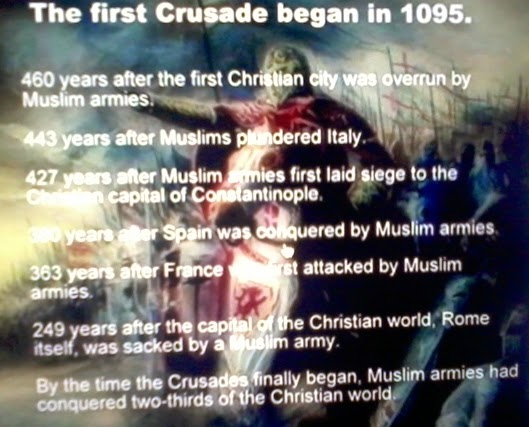
There is also the current, since perhaps the Second World War another monstrous invasion of Islamic and Third World parasites.
The Crusades were the Christian counter-attacks on Islamic incursions - see The First Crusade Came Very Late or, better see Early Muslim Conquests and the Muslim Conquest of the Levant in 634 to 638 AD.
The
Wikipedia tells us about the
Great
German Pilgrimage of 1064 to 1065 some thirty years before crusading
started. Around 10,000 pilgrims went overland and got treated rather badly.

There is
also the current, since perhaps the Second World
War another monstrous invasion of Islamic and
Third World parasites.
Pope Urban II
Was the man who brought us the First Crusade 1096 - 1099
First Crusade 1096 - 1099
People's Crusade
The People's Crusade is part of the First Crusade and lasted roughly six months from April 1096 to October. It is also known as the Peasants' Crusade or the Paupers' Crusade. Led by Walter Sans Avoir and Peter the Hermit, the army was destroyed by the Seljuk forces of Kilij Arslan.
T
https://en.wikipedia.org/wiki/First_Crusade
https://en.wikipedia.org/wiki/Second_Crusade
https://en.wikipedia.org/wiki/Third_Crusade
https://en.wikipedia.org/wiki/Fourth_Crusade
https://en.wikipedia.org/wiki/Fifth_Crusade
https://en.wikipedia.org/wiki/Seventh_Crusade
https://en.wikipedia.org/wiki/Eighth_Crusade
https://en.wikipedia.org/wiki/Ninth_Crusade
Early Muslim Conquests ex Wiki
The early Muslim conquests (Arabic: الفتوحات الإسلامية, al-Futūḥāt al-Islāmiyya), also referred to as the Arab conquests[4] and early Islamic conquests[5] began with the Islamic prophet Muhammad in the 7th century. He established a new unified polity in the Arabian Peninsula which under the subsequent Rashidun and Umayyad Caliphates saw a century of rapid expansion.The resulting empire stretched from the borders of China and the Indian subcontinent, across Central Asia, the Middle East, North Africa, and parts of Europe (Sicily and the Iberian Peninsula to the Pyrenees). Edward Gibbon writes in The History of the Decline and Fall of the Roman Empire:
Under the last of the Umayyads, the Arabian empire extended two hundred days journey from east to west, from the confines of Tartary and India to the shores of the Atlantic Ocean ... We should vainly seek the indissoluble union and easy obedience that pervaded the government of Augustus and the Antonines; but the progress of Islam diffused over this ample space a general resemblance of manners and opinions. The language and laws of the Quran were studied with equal devotion at Samarcand and Seville: the Moor and the Indian embraced as countrymen and brothers in the pilgrimage of Mecca; and the Arabian language was adopted as the popular idiom in all the provinces to the westward of the Tigris.
The Muslim conquests brought about the collapse of the Sassanid Empire and a great territorial loss for the Byzantine Empire. The reasons for the Muslim success are hard to reconstruct in hindsight, primarily because only fragmentary sources from the period have survived. Fred McGraw Donner suggests that formation of a state in the Arabian peninsula and ideological (i.e., religious) coherence and mobilization was a primary reason why the Muslim armies in the space of a hundred years were able to establish the largest pre-modern empire until that time. The estimates for the size of the Islamic Caliphate suggest it was more than thirteen million square kilometers (five million square miles).[6] Most historians agree as well that the Sassanid Persian and Byzantine Roman empires were militarily and economically exhausted from decades of fighting one another.[7]
It has been suggested that some Jews and Christians in the Sassanid Empire and Jews and Monophysites in Syria were dissatisfied and welcomed the Muslim forces, largely because of religious conflict in both empires.[8] It has also been suggested that later Syriac Christians reinterpreted the events of the conquest to serve a political or religious interest.[9] At other times, such as in the Battle of Firaz, Arab Christians allied themselves with the Persians and Byzantines against the invaders.[10][11] In the case of Byzantine Egypt, Palestine and Syria, these lands had been reclaimed from the Persians only a few years before.